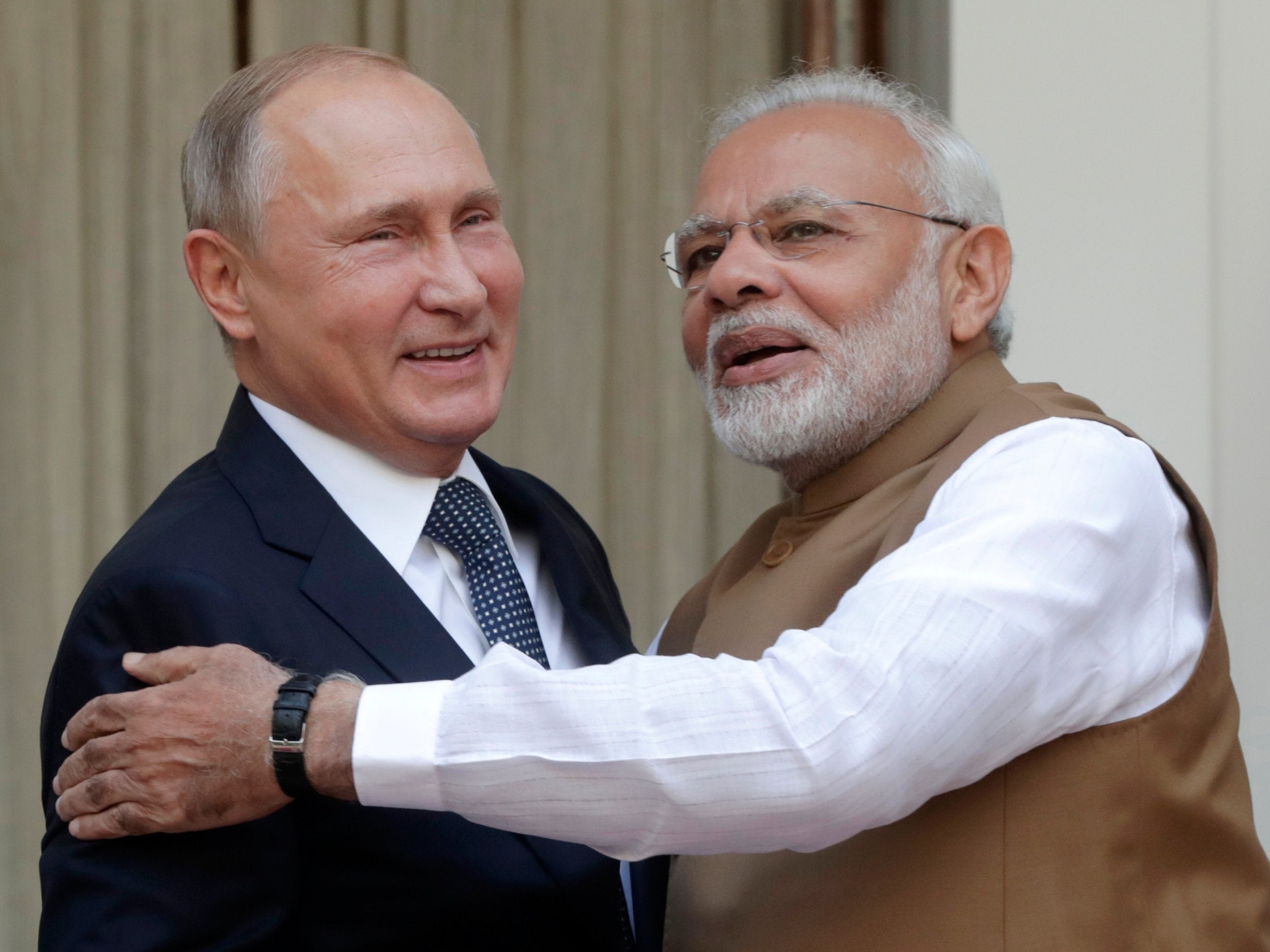A $5bn arms deal between Russia and India could incur the wrath of the US
Analysis: India is walking a fine line, says Adam Withnall, courting ever-closer relationships with both Washington and Moscow


India has agreed a deal to buy more than $5bn of S-400 ground-to-air missile defence systems from Russia, despite repeated warnings that doing so would force the US to hit it with sanctions.
The scale of the much-anticipated deal means it will almost inevitably come under the remit of a 2017 American law designed to hurt Moscow by limiting its ability to sell weapons around the world.
But if western leaders thought they had Russia’s president on the back foot with their united sting operation on alleged Russian cyberagents, Vladimir Putin showed no sign of it during a day of talks with India’s Narendra Modi in Delhi.

The pair beamed as they hugged for the cameras, and at a news conference in the afternoon they exchanged warm words about what Mr Modi called India and Russia’s “unique, special and privileged partnership”.
The S-400 deal has been a priority for both sides for some time, drastically improving India’s defensive capabilities in the face of the perceived, potential threat of Chinese fighter jets, and at the same time cementing Russia’s place as the world’s foremost exporter of ground-to-air missile systems.
Yet even observers who closely followed the exchanges between the two leaders on Friday could be forgiven for missing the flagship agreement of the summit.
There was no signing ceremony; not a single mention was made of the deal during the afternoon news conference; nor did it feature anywhere in the opening statements made by the two leaders and later published online.
Kremlin spokesperson Dmitry Peskov told reporters the agreement was “signed on the fringes of the summit”, and a spokesperson for the Indian government referred The Independent to “paragraph 45 of the joint statement” issued at the conclusion of the talks.
There, buried, was the standalone sentence that both sides “welcomed the conclusion of the contract for the supply of the S-400 Long Range Surface to Air Missile System to India”.
The fact is though, India is walking a fine line, courting ever-closer relationships with both Washington and Moscow. As the biggest military importer in the world, it can certainly afford to shop around – but it also seemed clear on Friday that it doesn’t want to push its luck.
India’s relationship with Russia is historically significant, with the pair enjoying good cultural and business ties for decades and the latter supplying much of the former’s military hardware, not least India’s ageing fleet of hundreds of Russian MiG fighter jets.
Mr Putin said his delegation “always arrive in India with great pleasure, as we know we are surrounded here in an environment of very frank friendship and business cooperation”. Mr Modi alluded to their shared history, saying Russia “has always been with us in the development journey of India”.
Yet only last month, India and the US held so-called “2+2” talks between their respective defence and foreign ministers, also in Delhi, where they agreed to sign an intelligence sharing deal long sought by the American side.
Then, Nirmala Sitharaman, India’s defence minister, said the deal “elevated India-US relations to unprecedented heights”. General James Mattis, possibly with a nod to Russia, said the breakthrough made their alliance “one of the most consequential in the region and in the world”.
The assumption at the time was that, with talks on the S-400 deal already well developed, India was caving in on its concerns over intelligence sharing in order to buy some American goodwill.
As things stand, Russia and the US are “equally close” in their relations with India, defence analyst Dr Gopalan Balachandran told The Independent. “But if the United States decides to impose sanctions that will have an impact on India, then that’s a different story.”
The problem is that even if the US State Department wanted to let India off with a warning, it couldn’t: the law governing sanctions on Russia – the Countering America’s Adversaries Through Sanctions Act (CAATSA) – was passed by Congress, not the executive, and compels the government to act against any entity that conducts “significant” business with the Russian defence or intelligence industries.
The US government does have the option to water down the sanctions it imposes, however, and to delay their imposition. China bought an S-400 system in 2017, but it did not feel the consequences of Washington’s wrath until September this year.
Of the 12 possible sanctions listed under CAATSA, only two would be seen as a genuine punishment by Delhi. One would see India’s defence minister personally blacklisted, the other – somewhat more sweeping in its impact – would ban India from buying any new American military hardware.
“One thing is sure, this is clearly a significant transaction and the determination will be made that India has to be sanctioned,” said Dr Balachandran. “The question is when, and how. That’s something only the State Department, and President Trump, can know.”
Join our commenting forum
Join thought-provoking conversations, follow other Independent readers and see their replies
Comments
Bookmark popover
Removed from bookmarks